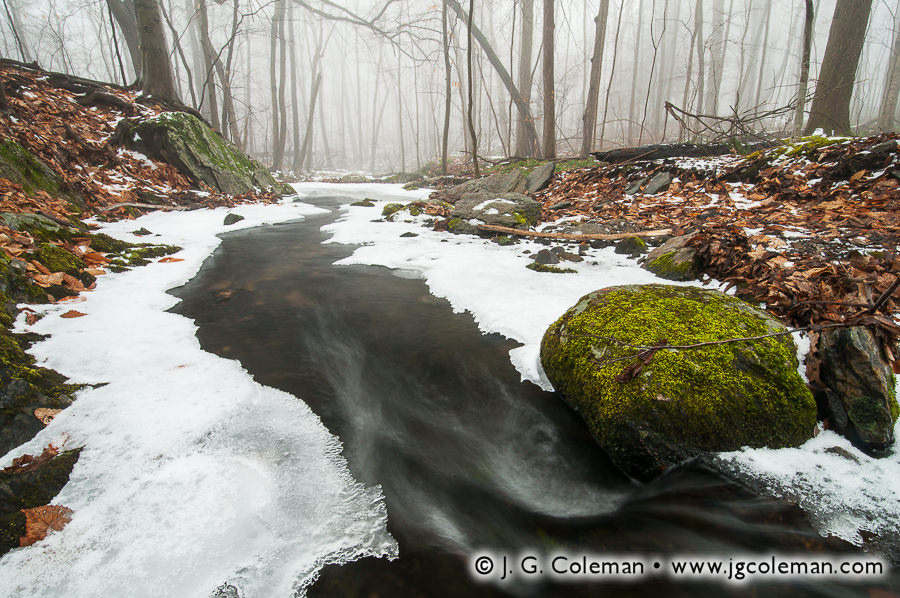
Unnamed branch of Wepawaug River, Alice Newton Street Memorial Park, Woodbridge, Connecticut
© 2013 J. G. Coleman Photography
With winter behind us and the spring renewal ahead, I find myself looking back through my last three months of work in search of the highlights of the past season. There have certainly been plenty, from a golden sunrise over the frigid Shepaug Valley in Washington to the icy cascades of Wepawaug Falls in the forests of Woodbridge (photo above). By far, though, my most enjoyable shoot this past winter was at the Ansonia Nature Center, a 150-acre parcel of woodlands and wetlands in Southern Connecticut.
I’ll be the first to admit that a small nature preserve in the equally small town of Ansonia, nicknamed the Copper City for its manufacturing prowess, hardly seems like a promising place to pursue the wild and rustic qualities that form the core of my landscape work. Factor in the high population density —more than 3,000 people per square mile— and you might just think I’ve lost my mind. But the fact of the matter is that you don’t need a thousand miles of wilderness to feel as if you’re thousands of miles away from the din of civilization. Within this swath of forest in Ansonia, I found a cozy microcosm of Connecticut’s natural landscapes.
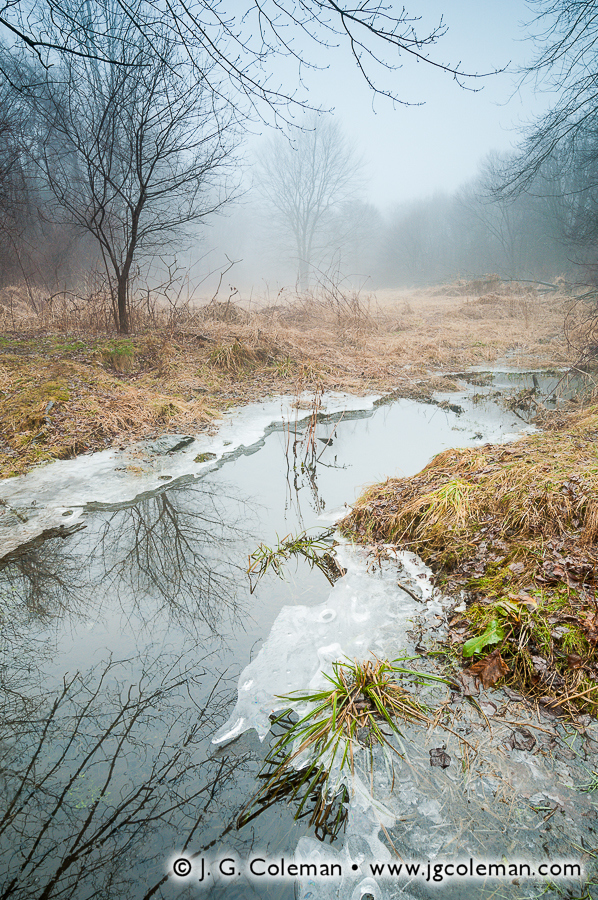
Two Mile Brook, Ansonia Nature Center
Ansonia, Connecticut
© 2013 J. G. Coleman Photography
Every open space worth its salt, for example, ought to have a watercourse of some kind. Two Mile Brook, a small stream that snakes its way through the western side of the Center, fits the bill and even possesses a delightfully dynamic character. When I first crossed this brook, only a few minutes into my hike, I found it lazily meandering through a wet meadow (photo at right). So subdued was its pace that its surface reflected the branches of nearby trees with mirror-like fidelity.
Yet, when I hooked back up with the Two Mile further north, it had an attitude altogether different. Now a lively brook, it weaved its way through the forest, dodging mossy boulders and murmuring energetically with occasional riffles. Indeed, the sound of a woodland brook is an aesthetic must-have that complements the Nature Center’s property nicely!
What’s more, Two Mile Brook has actually enjoyed quite a good deal of attention historically. As far back as the late 17th-century, it served as a useful landmark when drawing up property deeds. When the town of Derby was incorporated in 1720, for instance, Two Mile Brook was cited as its southern boundary. The banks of Two Mile Brook were even home to a number of mills throughout the 1800s, albeit in the more southerly stretches of the stream after it has gained some additional water volume and momentum.
Now is as good a time as ever to mention that, during my visit, the Ansonia Nature Center was cloaked with an absolutely exquisite blanket of mist. The temperature had managed to rise above 50° F, truly a rare occurrence for a late-January day in New England! The resulting mass of warm, humid air conjured a balmy fog that drifted across the landscape instilling an aura of both serenity and mystery. Conditions like this bring a veritable treasure trove of possibilities to a nature photographer, offering a marvelously ethereal means of conveying depth in a scene, as well as impeccably diffuse light that gently coaxes detail from shadowed surfaces.
Needless to say, even this spell of unusually warm weather wasn’t enough to melt away the ever-present traces of winter. Redwing Pond was still frozen over, such that rocks in the shallower sections sat half-entombed within motionless swirls of textured ice. Even along the woodland trails, there was no doubt that nature remained dormant. The only sounds to be heard were the occasional rustle of grey squirrels as they leapt cautiously from tree trunks to the forest floor, digging feverishly for hidden food stores amongst snow and thawed leaf litter.
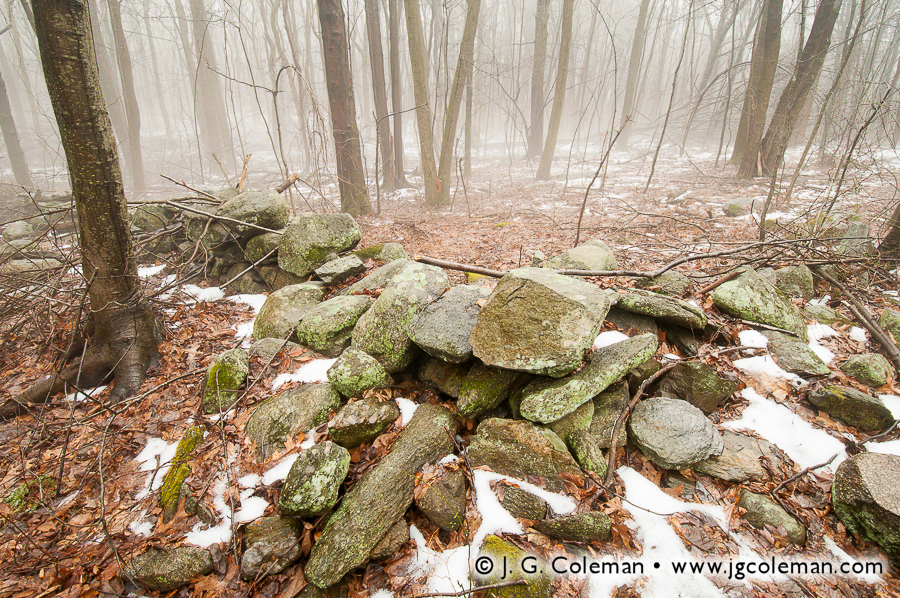
© 2013 J. G. Coleman Photography
Within the woodlands of the Ansonia Nature Center, we also find telling traces of human presence from a bygone era. Much of the acreage of the Center is now bristling with trees which, to the plain senses, might seem to have been here since time immemorial. But the fact of the matter is that this forest is actually relatively young, having slowly regrown upon the grassy expanses of what was once farm land. Evidence of this earlier use is found in the old fieldstone walls that criss-cross the Nature Center property (photo above). Looking at the place now, it’s truly difficult to imagine a time when this tract of land lacked all but a few shade trees and possessed a decidedly bucolic character.
On a quick side note, did you ever wonder how you can tell if an old stone wall delineated crop land or pasture land? The trick is to examine the stones themselves. When livestock pastures needed to be created, the process was fairly straight-forward: first you would cut down the trees, then you’d remove the largest, most obnoxious stones from the landscape and dispose of them by building them into a wall on the pasture perimeter. Thus, stone walls which were constructed around pastures were usually made almost entirely of large, loose-fitting stones. In contrast, land that was to be plowed and farmed required ever smaller stones to be removed from the soil, so the stone walls that bordered crop land would typically contain a wealth of smaller rocks.
The coarse stone walls I discovered at the Ansonia Nature Center were certainly characteristic of those that would’ve been built around pastures. Of course, we could skip a few steps and simply visit the Nature Center’s website, which explains that the property was originally “a small family-owned dairy farm”, but aren’t you glad that you learned a thing or two about how to interpret stone walls?
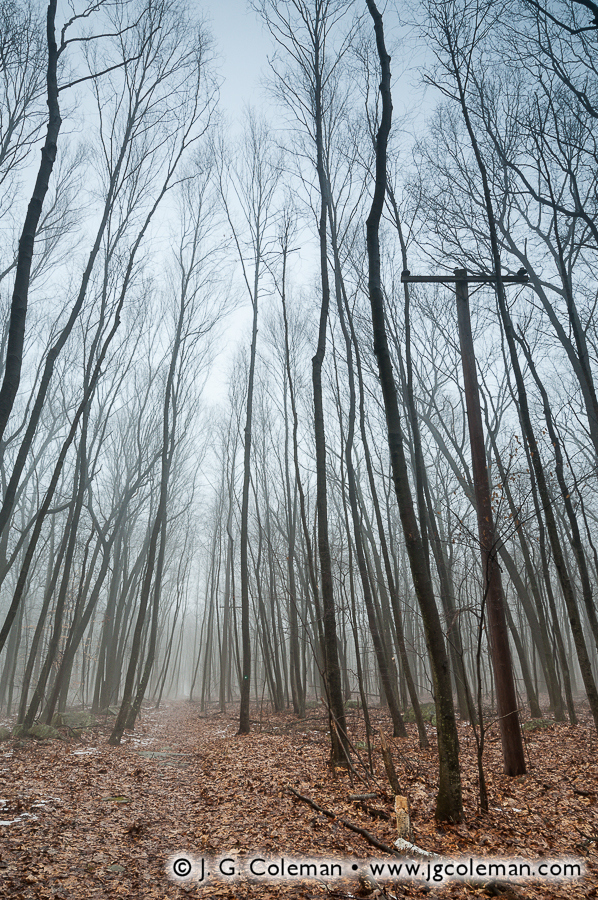
Relics of the old Nike BR-04 access road
along the Raptor Woods Trail
Ansonia Nature Center, Ansonia, Connecticut
© 2013 J. G. Coleman Photography
Surely, the most perplexing discovery of the day came as I walked through the forest along the Raptor Woods Trail in the northeastern corner of the Center. At one point I came to a straight-away where I could peer into the distance to see the unswerving stretch of trail ahead, flanked on both sides by a seemingly endless expanse of trees, each reaching longingly towards the featureless sky. But as I looked up at the bare crowns above, I was suddenly drawn to a peculiar horizontal shape amidst an otherwise vertical pattern of tree trunks. Right beside me, in the middle of the woods, stood a telephone pole (photo at right).
As I walked onwards, I realized that there were actually several telephone poles along this trail, each one evenly spaced from the next just as they would be along a suburban street. None of them were strung with wires, so I knew that they had been decommissioned, but I couldn’t begin to imagine how or why these telephone poles had come to be intermingled amongst trees almost twice as tall.
My curiosity was insatiable, so after I made it back to the trailhead and off-loaded my camera gear at the car, I decided to check out the visitor center. The building has a rather interesting design, whereby the interior space is basically circular with various exhibits around the perimeter and the main visitor center desk in the center. On this particular day, an older man (I regret that I didn’t catch his name) was manning the desk and I decided to see if he could shed some light on the peculiar telephone poles in the forest. “Oh, yes,” he explained,” that used to be an old access road for a missile base.”
Ah ha! Suddenly it all made sense. During a previous outing in the summer of 2012, I had hiked to the summit of Pinnacle Rock in Plainville, where one can still see the old concrete pads from a long-decommissioned Nike missile base. As it turns out, the telephone poles along the trail at the Nature Center are remnants of the control site access road for a similar installation dubbed “BR-04”, a missile base in Ansonia which was built in the mid-1950s to protect Bridgeport from the threat of bomber attacks.
For those of you that are scratching your heads over all this talk about missiles, here’s the abbreviated history. With the advent of the Cold War in the 1950s, there was concern that the most important cities and military bases in the United States were woefully susceptible to nuclear attacks by Soviet bombers. In response, the US government built anti-aircraft missile installations in strategic areas around each location with the goal of shooting bombers out of the sky before they could drop nuclear warheads. The installation in Ansonia was just one of a dozen sites in Connecticut that were tasked with defending Bridgeport and Hartford. Yet, for all of the effort and expense of building these installations, most of them were decommissioned less than a decade after they were built. By the late 1960s, the facility in Ansonia was one of only three sites that remained operational in Connecticut. All of these remaining sites were finally shut down in 1971. It’s not entirely clear why the old telephone poles along the access road in Ansonia were never taken down, but they make for a fascinating addition to the Raptor Woods Trail.
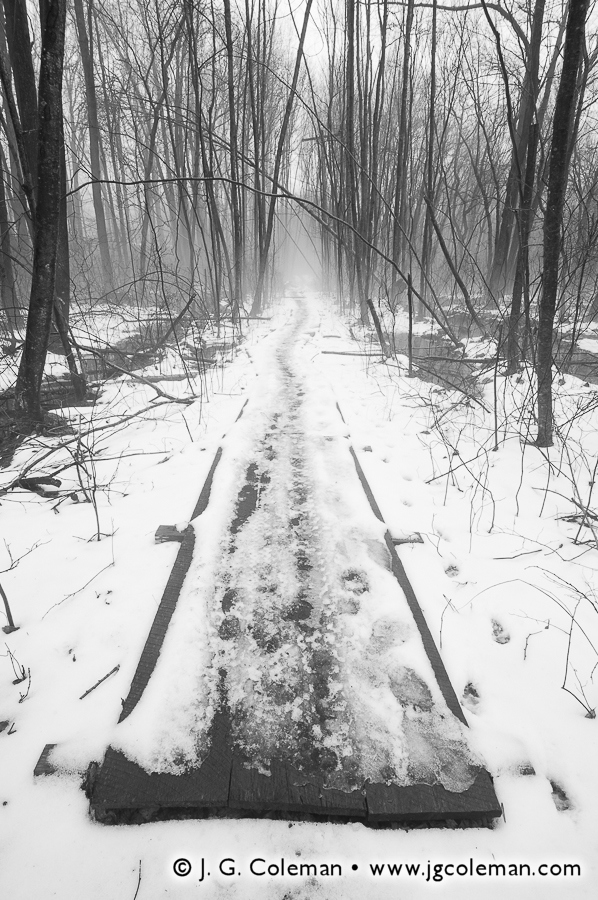
Ansonia Nature Center, Ansonia, Connecticut
© 2013 J. G. Coleman Photography
I’m always scouting new landscapes, trying to seek out and familiarize myself with places that are uniquely photographic. Inevitably, I return home some days having found nothing of particular interest, so I had no idea what I might discover when I set out for the Copper City on a misty day in January. But within only 150 acres at the Ansonia Nature Center, I was treated to a lively blend of woods and waters where tangible memories of years past lay concealed beneath the forest canopy. The dense suburbs of Ansonia are never more than a mile or two away from even the most secluded trails at the Nature Center, yet the forests here somehow manage to feel wild, remote and timeless.
This is a phenomenon I’ve come across often during the course of producing my landscape photography. The population density of the Nutmeg State is one of the highest in the nation, so in most places, open space is going to be measured in acres rather than square miles. Yet, in several populous areas across Connecticut, there are surprisingly “wild” pockets of land nestled skillfully into areas that are otherwise overwhelmingly tame. The Ansonia Nature Center is a shining example of a natural oasis amidst suburbia, but no matter where you live in the state, you’ll surely be able to find a refreshing piece of the natural world that is astonishingly close to home.
Purchase a Fine Art Print or Inquire About Licensing
Click here to visit my landing page for “Woodbridge Mist” to buy a beautiful fine art print or inquire about licensing.
Want to See More?
Be sure to check out all of my work from Ansonia Nature Center.







